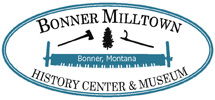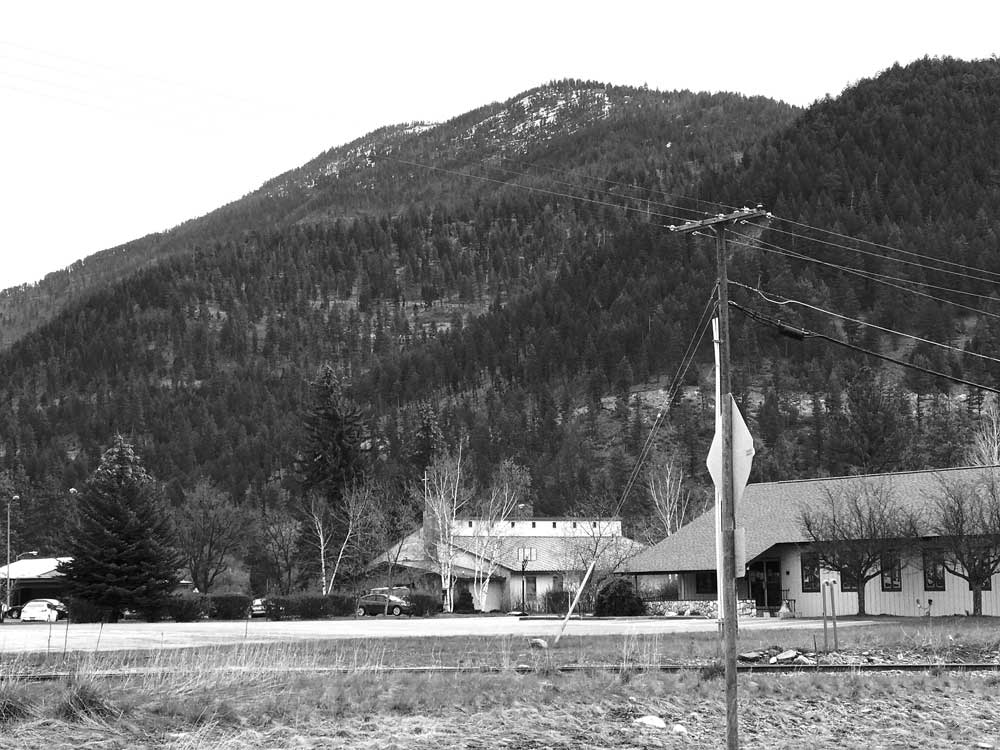The Churches
 Early 1900's Immigrant workers moved to the area to ply their skills as mill workers and lumbermen. Families followed and with it a desire for community including places of worship. Bonner has had a Catholic and Lutheran Church for more than a century.
Early 1900's Immigrant workers moved to the area to ply their skills as mill workers and lumbermen. Families followed and with it a desire for community including places of worship. Bonner has had a Catholic and Lutheran Church for more than a century.
St. Ann Catholic Church was founded in 1905. Although the church structure has been altered over the past century, the church itself stands on its original land that was donated by the Anaconda Copper Mining Company. St Ann is situated along Highway 200 between Bonner School and Our Savior’s Lutheran Church, but predates both.
St. Ann Catholic Church
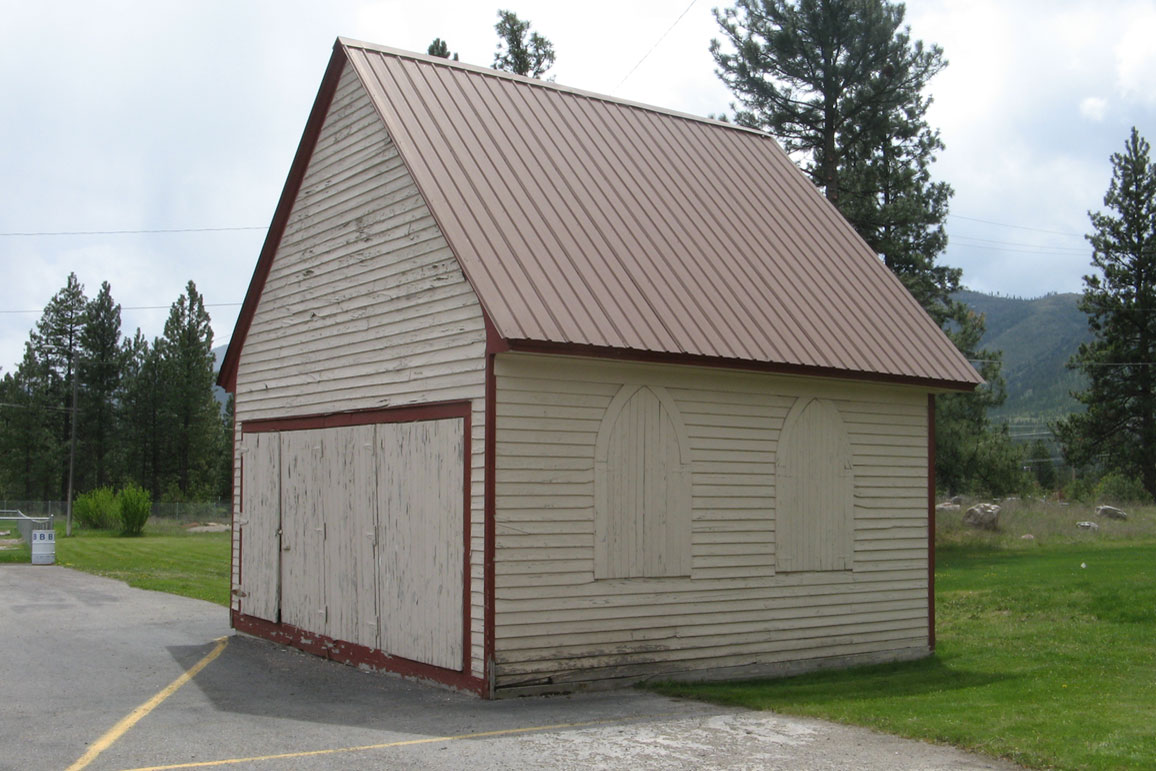 Part of the original church Rooted in its history of serving French Canadian loggers and millworkers at the start of the 20th century, St. Ann continues to serve new generations of parishioners in much different times in the 21st century.
Part of the original church Rooted in its history of serving French Canadian loggers and millworkers at the start of the 20th century, St. Ann continues to serve new generations of parishioners in much different times in the 21st century.
The Bonner mill had been operating nearly 20 years when the Catholic Church was built across the road on land donated by ACM. Beginning in 1905, St. Ann was a mission of St. Francis Xavier in Missoula. Fr. Lawrence Palladino of St. Francis Xavier described the Bonner parish “…where some forty Catholic families, mostly French Canadians, are living, the men being generally employed in the saw and planing mills and sash factory established in that locality.”
Architect A.J. Gibson designed the church. The same plans were used to build Woodman School. Today a part of the original church building serves as a storage shed for Bonner School.
After three years, St. Ann was removed from the St. Francis Xavier parish and attached to the St. John the Baptist parish of Frenchtown. Local historian Kim Briggeman writes of the change: “There were probably at least three reasons St. Ann was annexed to Frenchtown: St. Francis Xavier was being stretched to capacity as a growing Missoula’s lone Catholic parish; the French language bound Frenchtown and Bonner together, and Father LeGris had a car and he knew how to use it.”
At St. John the Baptist, Fr. LeGris preached in French. It’s not known, but very possible, that the monthly services at St. Ann were also in French.
In 1923 St. Ann became a mission of St. Anthony’s in Missoula and 17 years later, St. Ann became a parish in its own right. On October 1, 1938 Father John J. Connolly came from Helena to be the administrator. By June 10 of 1939 ground was broken for a bigger church, which was completed in 1940.
Church life continued and flourished. Vatican reforms in 1964 introduced English into the services. In the ‘70s Tuesday nights were set aside for religion classes in conjunction with the neighboring Lutheran Church. The church served approximately 120 families in Bonner, Turah, Clinton, Potomac, and Piltzville.
“In the early morning hours of January 2, 1985, fire broke out in the second St. Ann church…. A clock behind the altar was stopped at 1:45 a.m,” writes Kim Briggeman. The fire destroyed the altar, the sanctuary and the hall. Smoke and water damage affected other parts of the church.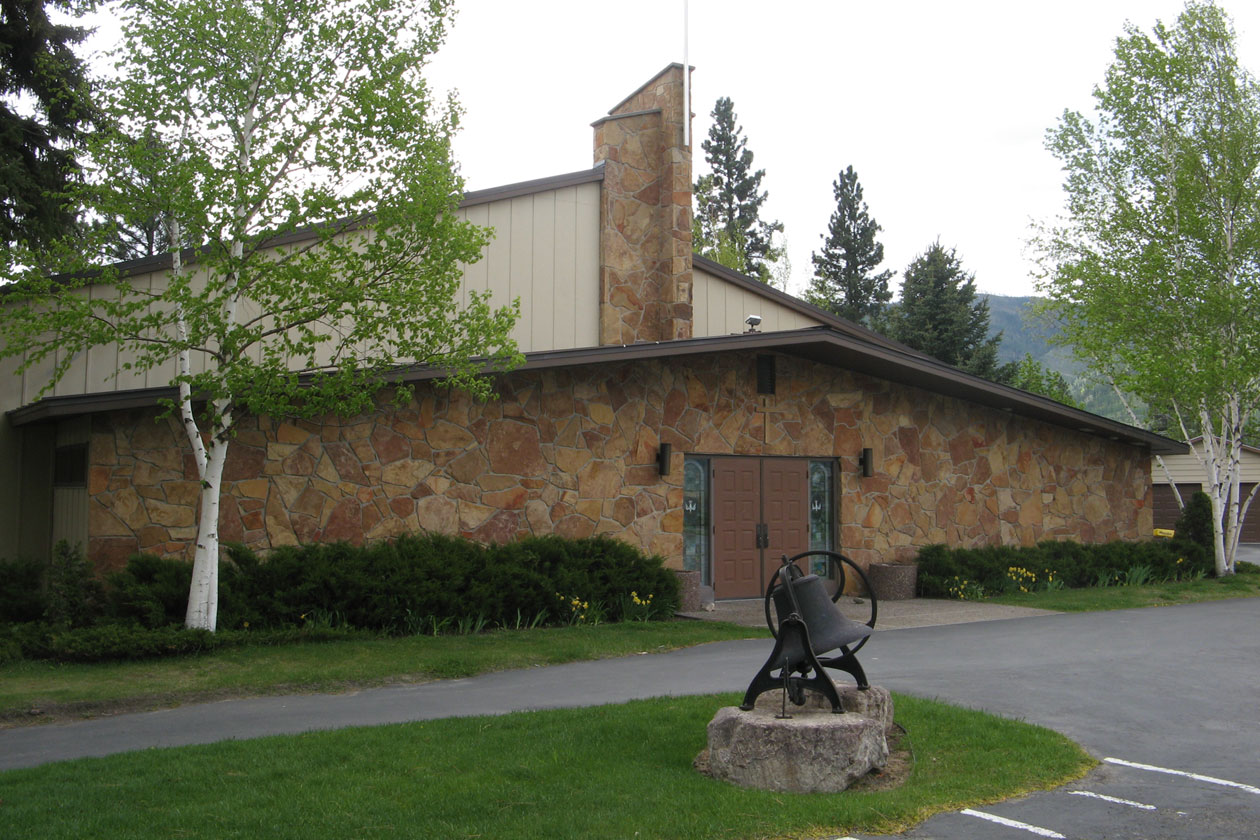 St. Ann, 2009 For 21 months, Catholic masses were held next door at the invitation of parishioners of Our Savior’s Lutheran Church. The parish members spent several months deciding what to do; ultimately they decided to demolish the old building and start anew. Finally, on Saturday, September 27, 1986 the first mass was held in the new church although construction wasn’t complete. The building was dedicated on December 7, 1986. In addition to church dignitaries, members of Our Savior’s Lutheran Church were special guests.
St. Ann, 2009 For 21 months, Catholic masses were held next door at the invitation of parishioners of Our Savior’s Lutheran Church. The parish members spent several months deciding what to do; ultimately they decided to demolish the old building and start anew. Finally, on Saturday, September 27, 1986 the first mass was held in the new church although construction wasn’t complete. The building was dedicated on December 7, 1986. In addition to church dignitaries, members of Our Savior’s Lutheran Church were special guests.
As part of the centennial celebration on September 10, 2005, the stained glass windows, saved after the devastating fire of 1985, were polished and displayed in the new church, another link from the past to the present.
Our Savior's Lutheran Church
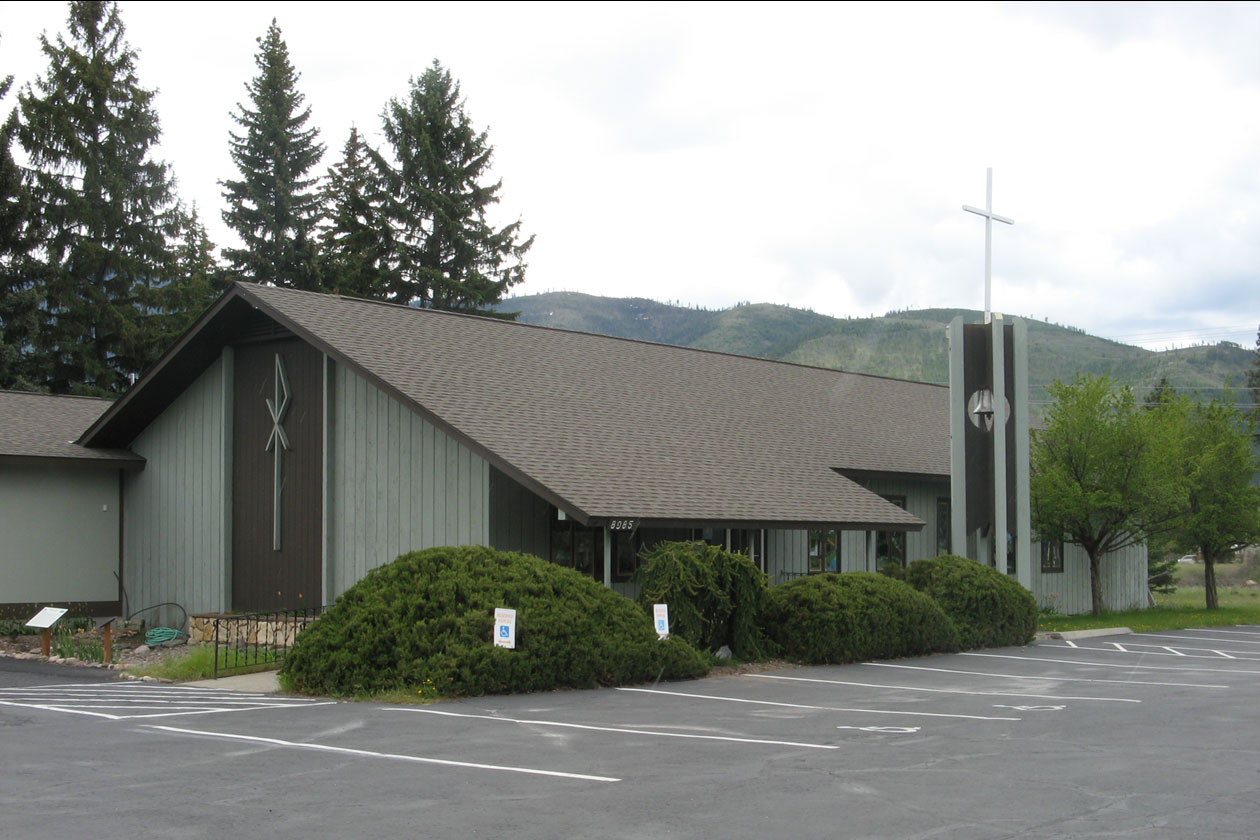 Our Savior's Lutheran Church, 2009 On March 11, 1908 the Lutheran congregation organized under the name of “Our Savior’s Evangelical Lutheran.” The 22 charter members met with Rev. E.B. Austvold at the home of Mr. and Mrs. Andrew O. Sylten in Riverside (now Milltown). “The original group of Lutherans consisted of 12 families, a total of 54 souls,” according to church records.
Our Savior's Lutheran Church, 2009 On March 11, 1908 the Lutheran congregation organized under the name of “Our Savior’s Evangelical Lutheran.” The 22 charter members met with Rev. E.B. Austvold at the home of Mr. and Mrs. Andrew O. Sylten in Riverside (now Milltown). “The original group of Lutherans consisted of 12 families, a total of 54 souls,” according to church records.
“At a meeting of the congregation on March 21, 1909, it was decided to make efforts to collect a fund with which to erect a church on a lot, midway between the villages of Bonner, Riverside and Piltzville, use of which was donated to us by Anaconda Copper Mining Company….The church was dedicated in October, 1910….Much of the credit for gathering the building fund together in such a short time is due the Ladies’ Aid which in addition to having regular meetings once a month at the homes of different members also held various kinds of socials and auctions.”
In the spring of 1913 lightning damaged the church and destroyed the organ. Repairs were made and a new organ purchased. On August 3, 1924, a few members of the former “Temperance Society” offered to transfer their hall to the Lutherans. This was accomplished a few years later and a new lease on the lot located just south of where the church was built was secured from the Anaconda Copper Mining Company. The new church and parish hall were completely destroyed by fire on August 27, 1932. By September 28 a contract was signed to build a new church. The first church services were held in the basement on December 18 and the completed church was dedicated on March 12, 1933.
In June, 1966, a new church was dedicated. The existing church was moved to Clinton where it serves as the Community Center.
Church records reveal interesting insights into the early church: “In the original constitution adopted March 11, 1908, voting power was restricted to male members twenty-one years of age and older. This was amended on January 2, 1930 to read: ‘That the voting membership of our congregation be composed of all confirmed members eighteen years of age and older.’”
“In the early history of our congregation, practically all the sermons were preached in the Norwegian language. This was later changed to fifty percent of the services each month in Norwegian and fifty percent in English. On January 5, 1932, this was again changed to a schedule calling for only the last Sunday in the month in the Norwegian language.”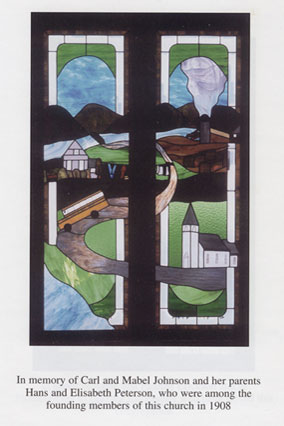 Stained glass window Our Savior’s Lutheran Church has ministered to its congregation for more than a century. In that time the church has developed two unique ministries. Former Pastor Carl Rohr recalled that Mimi Mallot moved to the area from San Diego and became and enthusiastic member of the congregation. Mimi, noticing that one of the stained glass windows was cracked, offered to have it repaired. This planned repair was scrapped when Mimi decided to donate a new stained glass window. The church council agreed to formulate a plan for ten new stained glass windows with the idea that if Mimi’s window were the only one to be installed, it would be treated as a piece of art.
Stained glass window Our Savior’s Lutheran Church has ministered to its congregation for more than a century. In that time the church has developed two unique ministries. Former Pastor Carl Rohr recalled that Mimi Mallot moved to the area from San Diego and became and enthusiastic member of the congregation. Mimi, noticing that one of the stained glass windows was cracked, offered to have it repaired. This planned repair was scrapped when Mimi decided to donate a new stained glass window. The church council agreed to formulate a plan for ten new stained glass windows with the idea that if Mimi’s window were the only one to be installed, it would be treated as a piece of art.
Based on the theme of church hymns, the windows were dedicated one by one as families and friends embraced the idea. The installation of each window has brought laughter and tears as the congregation remembers the people and stories which tangibly surround them in their worship.
The Prayer Quilts is another ministry begun in 2003 in honor of Sophie Jacobson. The layers of each quilt are stitched together with heavy threads. As each knot is tied, a silent prayer is offered for someone in need and then the quilt is given to that person. More than 70 of Sophie’s Quilts had been given from 2003-2008.
Sources:
A Grass Roots Tribute: The Story of Bonner, Montana. Bonner Bicentennial Committee.
Our Savior’s Lutheran Church Centennial Memories 1908-2008. Compiled by members, Our Savior’s Lutheran Church.
Communities
Communities at Play
Sleigh Riding in Bonner, Montana
Glen Max Smith, aka "The Hooligan," recalls sledding adventures on Bonner Mountain using Flexible Flyers, skis, boxes, and Coca Cola signs.
